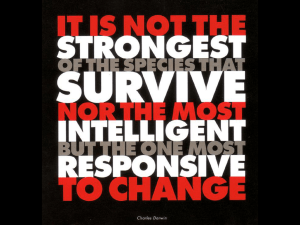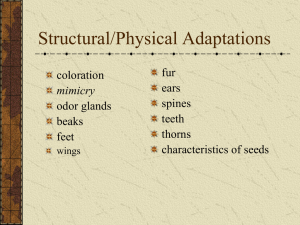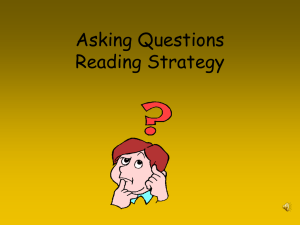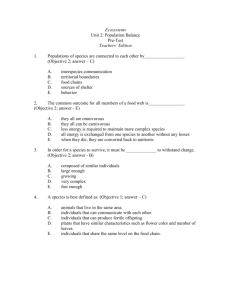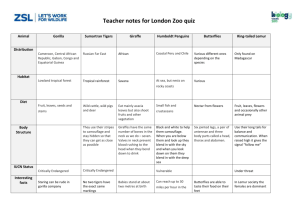lesson11
advertisement
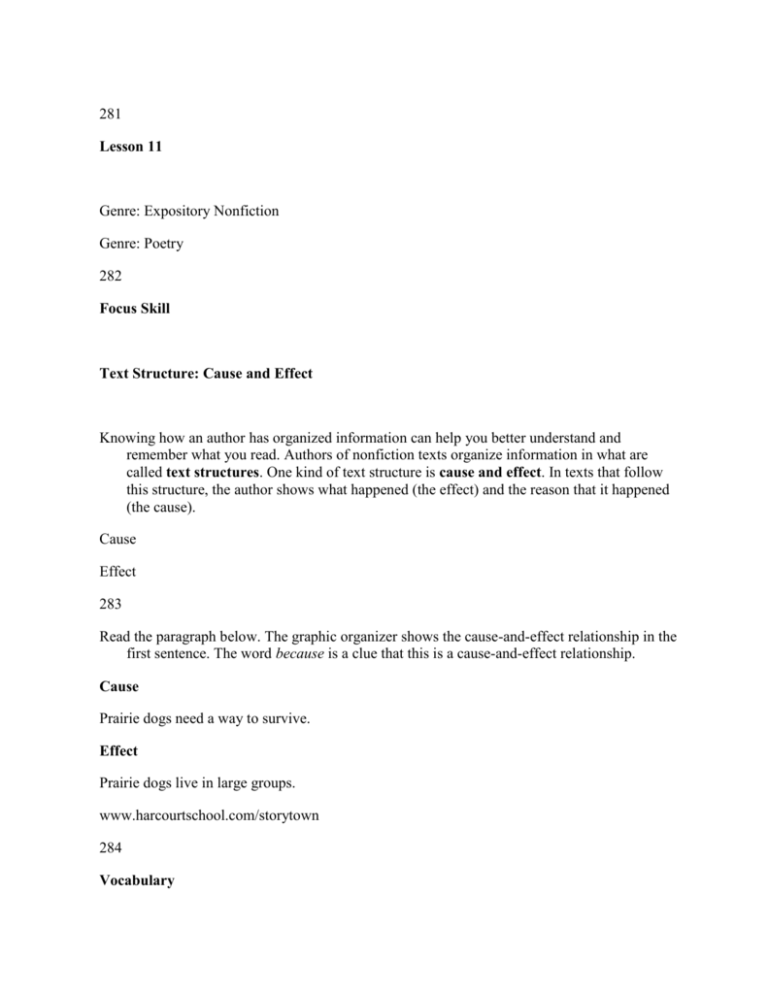
281 Lesson 11 Genre: Expository Nonfiction Genre: Poetry 282 Focus Skill Text Structure: Cause and Effect Knowing how an author has organized information can help you better understand and remember what you read. Authors of nonfiction texts organize information in what are called text structures. One kind of text structure is cause and effect. In texts that follow this structure, the author shows what happened (the effect) and the reason that it happened (the cause). Cause Effect 283 Read the paragraph below. The graphic organizer shows the cause-and-effect relationship in the first sentence. The word because is a clue that this is a cause-and-effect relationship. Cause Prairie dogs need a way to survive. Effect Prairie dogs live in large groups. www.harcourtschool.com/storytown 284 Vocabulary Build Robust Vocabulary predators traits lure mimic resembles obvious deceptive avoid Surprises in Nature A plant called the Venus’ flytrap is one of nature’s surprising predators. One of the plant’s most unusual traits is that it eats insects! The sweet-smelling leaves of the Venus’ flytrap lure insects such as wasps, spiders, and flies. When an insect moves around on a Venus’ flytrap leaf, it touches tiny hairs that signal the two parts of the leaf to close. Snap! In less than a second, the insect is trapped and becomes the plant’s next meal. It takes 8 to 10 days for the Venus’ flytrap to digest an insect that it traps. 285 Amazing Sea Creatures The puffer fish can mimic the appearance of a larger, dangerous-looking fish to disguise itself from enemies. When the puffer fish is calm, it resembles many other fish in the ocean. It doesn’t look like an obvious danger. As soon as the puffer fish senses danger, however, it swallows water and grows to two or three times its normal size. The deceptive appearance keeps it safe from predators. The puffer fish inflates itself to avoid being eaten by enemies in the ocean. www.harcourtschool.com/storytown 286 Mimicry And Camouflage 287 288 289 There are insects that look like flowers, flowers that look like insects, plants that smell like dead meat, and birds that sound like snakes. The world is full of creatures that are not what they seem to be. Some mimic other living things. Others are camouflaged, which means they blend in with their surroundings. The surprises and disguises involved in mimicry and camouflage are all around us. In the forest, at the bottom of the sea, and in our own backyards, living things are constantly tricking each other. These tricks are not for fun, though. They are adaptations: traits that help plants and animals to survive. NATURE NOTE: Chameleons are perhaps the most famous color-changing animals. Scientists think this ability helps them to communicate as well as hide. 290 Hidden Critters In the corner of a yard is a pile of dead leaves. Suddenly, a bit of the pile hops away. What had seemed to be a dead leaf was really a blotchy brown toad. The toad’s color and markings disguised it in a way that made it blend perfectly into its surroundings. Camouflage, also known as cryptic coloration, helps some living things avoid becoming another creature’s meal. Many birds’ eggs have speckles and spots that make them harder for predators to see than a bright white egg would be. The dapples on the back of a whitetailed deer fawn allow it to blend into the pattern formed by sunlight filtering through tree leaves in the forest. Of course, predators can play the hiding game, too. The stripes of a tiger help it blend into tall grass so it can sneak up on animals such as wild pigs and antelope. If a polar bear were black instead of white, it would have a much harder time surprising seals and other prey animals amid snow and ice. NATURE NOTE: A zebra’s stripes help disguise it by making it hard for predators to tell where the zebra’s body stops and its surroundings begin. 291 There is a toad hidden in this pile of leaves. 292 NATURE NOTE: Phasmid, the scientific name for sticklike and leaflike insects, is related to the words fantasy and fantastic. Sticks and Stones Instead of coloring that helps them blend into the environment, some animals have disguises that make them look like other living or nonliving things. Some katydids (a kind of grasshopper) look almost identical to leaves. Insects known as phasmids look like sticks or leaves. NATURE NOTE: One phasmid, known as Pharnacia serratipes, grows to be a whopping 13 inches (33 cm) long! 293 Six of these “rocks” are actually small plants. The pebble plant, which grows in southern Africa, escapes the attention of ostriches and other animals that might like to eat it because it looks like stones scattered on the desert floor. Some species of spiders and moths escape enemies because they look like bird droppings. Some leaf beetles look like caterpillar droppings. 294 Looks Like Trouble Some kinds of mimicry make an animal more obvious instead of less obvious. How does this help it to survive? By sending a message to predators and pests that says, “I’m trouble.” This harmless beetle mimics a dangerous wasp. The common wasp stings animals that threaten it. Animals that get stung learn to avoid wasps. Hornet moths, wasp beetles, and hoverflies don’t sting. But they don’t have to. They have markings that mimic the markings of the common wasp. Animals that have learned to avoid wasps also avoid these harmless insects. Even though these insects are harmless, their ability to mimic the common wasp helps save them from becoming another animal’s meal. A plant or animal that is not itself bothersome or dangerous, but wards off predators by looking like something that is, is called a Batesian (BAYT•see•un) mimic. This fly can’t sting, but it looks as if it might. NATURE NOTE: The larva, or wormlike young, of a hawk moth has large spots that make it look like a dangerous snake with scary eyes. 295 Trouble Times Two Another kind of mimic is a Müllerian (myool•lR•ee•uhn) mimic. Müllerian mimics not only mimic a creature that is harmful or undesirable, they also are harmful or undesirable themselves. How does the mimicry help them? By increasing the likelihood that a predator will learn to leave creatures with that particular look alone. The monarch butterfly is poisonous if eaten. For example, butterflies called viceroys look like monarch butterflies. Both monarchs and viceroys contain chemicals that make birds that try to eat them sick to their stomachs. If a bird tries to eat a monarch, it quickly learns to avoid orange butterflies with black markings. If it tries to eat a viceroy, it learns the same lesson. Because birds get the same message from both kinds of butterflies, they learn to avoid them a lot faster than they would if only monarchs or only viceroys tasted bad. NATURE NOTE: Monarch-like viceroy butterflies were once considered an example of Batesian mimicry. But recently scientists discovered that viceroys taste bad, too. 296 Fish swim right into the mouth of this turtle. Fatal Attraction At the bottom of the Mississippi River, a little pink worm wiggles around. A fish swims up to it for a tasty bite. Then, suddenly, a pair of jaws snaps shut on it! The worm is not a worm, but part of the tongue of an alligator snapping turtle. By mimicking a worm, the turtle is able to lure fish right into its mouth. 297 The anglerfish mimics a worm to catch fish. Some tropical fish also use this kind of foolery. Certain types of anglerfish have one fin that looks like a worm. When other fish come up to eat the “worm,” the anglerfish sucks them into its mouth. The African flower mantis, a type of large insect, plays a similar trick on land. The mantis looks like a bright flower. When an insect flies up to find nectar, a sweet liquid produced by flowers, it becomes the mantis’s meal instead. This mantis looks as harmless as a flower petal. 298 The rotten scent of skunk cabbage lures flies. Scents And Lights Deceptive odors can attract prey, too. The female bolas spider, found throughout much of North America, hangs a ball of sticky silk from a silky string. Then she gives off a scent that resembles that of a female moth. When male moths in the area catch the scent and fly in to find the female, the spider traps them by hitting them with the sticky ball. The skunk cabbage, which grows in bogs and swamps, also uses odor to attract insects. The soil in which this plant grows doesn’t have much nitrogen, a nutrient that plants need to grow. But the skunk cabbage has another way of getting nitrogen. It gives off heat and a stinky smell, like that of rotten meat. Flies and other insects in search of a dead animal on which to lay eggs fly in and get trapped in a little pool of water at the base of the skunk cabbage. As the insects decay, the plant gets the nitrogen it needs from their dead bodies. 299 A firefly’s flash can attract a mate or a meal. Photuris (foh•TOOR•uhs) fireflies mimic behavior to get their meals. Fireflies flash in the night to attract mates. Each species has its own pattern of flashing. Female Photuris fireflies mimic the flashing pattern of other species of the genus Photinus (foh•TYN•uhs). The flashing attracts Photinus males. But instead of meeting a mate, they became a meal for the larger Photuris female. Like A Glove From plants that smell like dead meat to bears and hares that look like snow, the world is full of creatures that use mimicry or camouflage to make their way through life. Like a hand in a glove, these creatures fit perfectly into the environment around them. 300 Think Critically 1 Why do plants and animals use mimicry or camouflage? TEXT STRUCTURE: CAUSE AND EFFECT 2 What is the main idea of the section titled “Sticks and Stones”? What details support the main idea? MAIN IDEA AND DETAILS 3 What do you think is the strangest way an animal uses mimicry or camouflage? Use details from the selection to support your answer.PERSONAL RESPONSE 4 Imagine that you are standing in a thick forest. How might you camouflage yourself? MAKE CONNECTIONS 5 WRITE Tell how animals that use scents and animals that use lights are ALIKE and DIFFERENT. Use details and information from the selection to support your answer. SHORT RESPONSE 301 About The Author Mary Hoff Mary Hoff divides her time between writing about science and enjoying her family. Her interest in science began in college. She had been studying science and working in laboratories. Mary Hoff soon decided that she wanted to be an author. She began writing about many different science topics. Mary Hoff lives in Minnesota. She enjoys writing about the natural environment in her home state for a local magazine. Once she wrote about Minnesota animals that fool each other by using mimicry and camouflage. www.harcourtschool.com/storytown 302 lizards, frogs, and polliwogs Science Poetry The Chameleon Chameleon, comedian, We never know which skin you’re in. Sometimes you’re yellow, Then you’re green, Turquoise blue, or tangerine. Chameleon, you’re hard to find. Comedian, make up your mind! 303 The Glass Frong Upon a tree It’s hard to see Which part is leaf And which is me Which part is me And which is leaf I’ve lost myself again –Good grief! The Poison-Dart Frog Brown with oval orange spots. Crimson mottled black with blots. Neon green with blue-black bands. Tangerine with lemon strands. Banana yellow. Ultramarine. Almost any color seen. And though their poison can tip a dart, These frogs are Masters of Fine Art. 304 Connections Comparing Texts 1. Some animals blend into their surroundings. Others stand out. Which type are you more like? Explain. 2. How are “Mimicry and Camouflage” and the poems from “lizards, frogs, and polliwogs” alike? How are they different? 3. What are some ways people, like animals, adapt to their environment? 305 Cause Effect 306 Reading-Writing Connection Analyze Writer’s Craft: Expository Nonfiction Expository nonfiction gives facts and information about a topic. It may include headings, diagrams, photographs, and captions. When you write expository nonfiction, you can use the work of authors such as Mary Hoff as writing models. Read the passage below from “Mimicry and Camouflage.” Note how the author used conventions and a cause-andeffect text structure. 307 Explanatory Essay An explanatory essay is a kind of expository nonfiction. It explains how or why something happens. A student named Christine wrote the explanatory essay below. In it, she explains why butterflies are attracted to her garden. As you read Christine’s essay, notice how she organizes her ideas. 309 Now look at what Christine did to prepare to write her explanatory essay. Cause flowering plants Effect attract butterflies Cause sun and shade Effect attract butterflies Cause water Effect attracts butterflies Organizing Ideas First, she chose a subject she understands well: how to attract butterflies to a garden. Then she used a graphic organizer to help her organize the causes and effects in her essay. Outlining Christine wrote an outline to organize the three main causes she will explain in her essay. The outline shows her plan for writing an introduction, a paragraph explaining each main cause, and a conclusion. Title: Beautiful Attraction I. Introduction A. Our butterfly garden B. Three causes that attract butterflies II. Cause #1 - Flowering Plants A. Daisies and violets B. Red Admirals and Monarchs III. Cause #2 – Sun and Shade A. Butterflies are cold-blooded. B. Create sunny and shady areas. IV. Cause #3 - Water A. Make a permanent puddle. B. Add fruit to the puddle. V. Conclusion A. Mention three causes again. B. Why we love our garden

